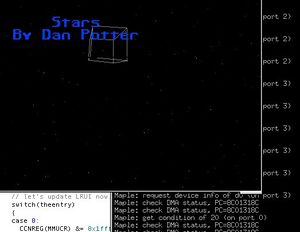Dreamcast emulators: Difference between revisions
Jump to navigation
Jump to search
| Line 95: | Line 95: | ||
===Dreamer=== | ===Dreamer=== | ||
*Developed by ElSemi in late 2000 into mid-2001, Dreamer was the first working and released Dreamcast emulator for PC. | *Developed by ElSemi in late 2000 into mid-2001, Dreamer was the first working and released Dreamcast emulator for PC. | ||
*Latest version: Alpha 0.25 - Download [ | *Latest version: Alpha 0.25 - Download [https://files.dcemulation.org/software/dcemulators/dreamer/dreamer002.zip v0.02] | ||
*[Dreamer](http://emulatronia.com/dcemu.htm) | *[Dreamer](http://emulatronia.com/dcemu.htm) | ||
*SH4: All opcodes is emulated (100% have not been proven) interprets. Those of movements of data to memory and jumps are emulated using dynamic recompilación. | *SH4: All opcodes is emulated (100% have not been proven) interprets. Those of movements of data to memory and jumps are emulated using dynamic recompilación. | ||
Revision as of 21:34, 3 March 2023
Emulators can be very handy when you want to test code quickly, but can't be totally relied on. Some emulator are closer to the original console while some will run your game even if a real Dreamcast can't.
Reicast
- Official page: [1]
- Developed by: skmp, others. Derived from nullDC.
- Status: Active, Under rewrite
- Platform: Android, Windows, Linux, macOS, html5
Supported features
Known issues
- Extremely buggy
Redream
- Official page: [2]
- Developed by: inolen
- Status: Active
- Platform: Android, Windows, Linux, macOS
Supported feature
Known issues
- No sound support for homebrew with HLE bios
NullDC
- Official page: [3]
- Developed by: skmp, ZeZu, PsyMan
- Status: Inactive
- Platform: Windows
Supported feature
Known issues
lxdream
- Official page: [4]
- Developed by: nkeynes
- Status: Inactive
- Platform: Linux and macOS
Supported feature
-DEV Console support (printf)
Known issues
lxdream-nitro
- Official page: [5]
- Platform: Linux and macOS
- A community-improved version of lxdream
Demul
- Official page: [6]
- Developed by: Wind, CaH4e3, ajax16384, DreamZzz, MetalliC
- Status: Inactive
- Platform: Windows
Supported feature
- MMU, Naomi 2
Known issues
WashingtonDC
- Official page: [7]
- Developed by: snickerbockers
- Status: Active
- Platform: Linux, Windows
Supported feature
- Console support (printf) via serial port
- remote GDB debugging
Known issues
- game compatibility
- Z-Fighting
MAME
- Official page: [8]
- Developed by: MAME community
- Status: Active
- Platform: Linux, Windows
Supported feature
Known issues
- game compatibility
- speed
Other older emulators
These emulators are listed mostly for historical/archival reasons.
Chankast
- Chankast is a Dreamcast emulator for Windows. Released on May 29th, 2004, Chankast was the first publicly-released Dreamcast emulator to play commercial games playably. It is now considered outdated.
- Authors: baktery, unai and garrofi
- Homepage
- Latest version: Alpha 0.25, 07/07/2004
Makaron
- Makaron
DreamEmu
- Developed by Lord Cheese, DreamEmu is an early Dreamcast emulator that can only run some tech demos and homebrew, last released on 10/28/02.
- Downloads: 0.0.4.1, v0.03 - 08/03/01, v0.02, v0.01a
- Homepage
Dreamer
- Developed by ElSemi in late 2000 into mid-2001, Dreamer was the first working and released Dreamcast emulator for PC.
- Latest version: Alpha 0.25 - Download v0.02
- [Dreamer](http://emulatronia.com/dcemu.htm)
- SH4: All opcodes is emulated (100% have not been proven) interprets. Those of movements of data to memory and jumps are emulated using dynamic recompilación.
- FPU: All opcodes emulated for want of the 2 specific instructions of the Dreamcast. > uses the interpreter - Slow.
- PowerVR: The basic part of the hardware 2d works (Framebuffer correctly and control registries). It lacks the way of video 555. We are at the moment looking for information on the hardware 3d and display lists.
- JoyPad: Emulated completely.
- Maple Bus: The control registries have been identified and will be working shortly.
- Sound: Nothing yet.
- CDROM: Almost emulated.
- DEBUGGER: The emulator takes integrated to debugger (that is a little patatero but it plays his role). Executing debugger implies that the execution of the program is much more slow. The handling keys are the following ones:
- F5: Go (uninterrupted Execution)
- F7: Draw up Into (to execute entering the subroutines)
- F8: Step Over (To execute without entering the subroutines, does not work to 100%)
- Commandos: The commandos are written in the inferior part of the window of the code:
- G (Just as F5)
- G direction (Executes until that direcci¢n. in hex)
- D direction (shows the memory of the specified direction. in hex)
- D registry (it shows the memory of the direction loaded in the chosen registry)
- And direction data (writes in the direction the specified data. 0-FF in hex)
- R registry value (loads the value in the registry. 0-FFFFFFFF in hex)
- S (it stops the single emulation works in Go way)
- F (it draws framebuffer)
- X (to leave)
- Z (reset, cracks, not to use)
- WD 0|1 (oculta|muestra window of data)
- WR 0|1 (oculta|muestra window of registries)
- WM 0|1 (oculta|muestra window of messages)
- WC 0|1 (oculta|muestra code window, nor is happened to you, but where you write)
- G (Just as F5)
Swirly
- [Swirly](http://swirly.sourceforge.net/)

